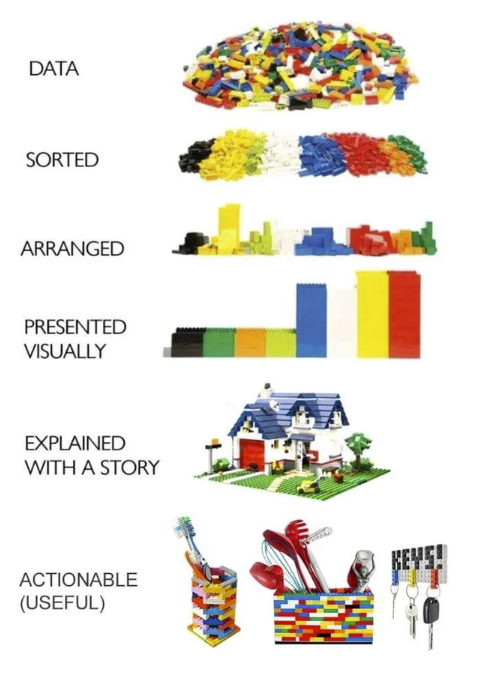
Exciting News! Outbase unveils its groundbreaking AI Assistant – your new campaign creation co-pilot. It's a smarter, faster way to reach your sales goals!


What data enrichment is, why you need it, and how it can help marketers find better leads and get more sales.
The key to unlocking successful marketing campaigns lies in the richness of your data. The more layers of information you have on your customers, the better. Think of it like adding layers to a cake – the more layers you add, the more delicious it becomes. And who doesn’t love delicious cake?
That’s where data enrichment comes in. It helps you get the most out of your data to make scrumptious sales and marketing choices. Here’s what you need to know about data enrichment in B2B marketing.
B2B data enrichment is all about improving the quality of the data you’ve already got. It’s the process of collecting and assigning additional layers of information surrounding your customers, so you can get a 360-degree view of them.
Enriched data goes above and beyond the standard data set, accelerating your lead generation and helping you convert those leads into customers. Yummy.

Enriched data allows you to capture what we could describe as ‘real life’ information and actually use it to tell a story. Not only does this up your selling game, but it also increases your competitor advantage – the icing on the cake.
There are three specific marketing aspects that can be improved by enriching your data:
Let’s slice it up.
It’s all about working smart, not hard. Enriching the data on EVERYONE in your database might seem like an incredibly daunting task. And it is. But like so many big tasks, it can be broken down into manageable bites – starting with segments.
Segmentation saves you time. By grouping certain types of customers together, you can compare customers inside the segments, and the segmented groups against each other. There are three different types of segmentation, think of them like the sponge, filling, and icing:
Demographic segmentation (the sponge): This is the most basic level of customer segmentation, and sorts your customers into groups on the basis of things like business size, age, type, income, number of employees etc.
Behavioral segmentation (the filling): What else might set your clients apart? Customer behavior can include things such as product preferences, buying habits, typical budget, and any other important patterns relevant to your specific business model.
Needs segmentation (the icing): After all that, what’s missing? Identifying a customer’s needs is where your power lies. Providing a solution to those needs puts you in the best possible position for closing a sale when the time comes.
Lead scoring goes hand in hand with segmentation and customer profiles. You can use your newly-enriched data to inform your lead scores, giving your campaigns clear, calculated direction. Get clued up on the basics in our complete guide to lead scoring.
When it comes to bagging new business, personalization works. But data enrichment lets you go above the usual ‘mail merge’ entries like name and company.
With the right tools, you can tailor your customer messaging to include details like recent updates on their business, and facts about previous sales.
Consider the annually released Spotify Wrapped campaign. What makes this campaign so popular? It’s the personalization. It’s the way that Spotify, a global platform, makes every single end-user feel valued, listened to (pardon the pun), and appreciated. The users like it so much it’s even frequently shared to social media for all their peers to appreciate, too. Pretty delicious marketing, right?
You’ve got your data set and you’ve weighed out the ingredients thoroughly. Now how do you go about adding the layers and actually ‘enriching’ that data?
You have to use multiple data sources! Here’s the most popular ways to do it:
You can use web scraping tools (also referred to as web harvesting, or web data extraction) to take data from your customers’ websites. Do they have a blog? Are they displaying their customer reviews? Are there extra contact details you can add to your database?
This data can give you insights into what they offer, their ideal customers, and their preferred communication channels.
Have they previously interacted with your brand on social media through messages, comments, likes or shares? Are other people talking about them on social media?
You can use social listening tools to track mentions of their brand, competitors, and industry topics to identify their needs and challenges.
You might have potential customers who’ve already engaged with your previous communications. Have they responded to any marketing campaigns? Which emails have they opened or clicked on? Have they used your chatbot before?
This data can help you understand your customers’ interests and preferences, as well as their previous engagement with your content and offerings.
The best thing about customer surveys? You can ask people directly what they think. What are their pain points, desired features, and satisfaction levels with your products or services?
This information can help you identify areas for improvement and prioritize your customer retention efforts.
Using multiple data sources gives you a more rounded idea of your customers. Data extraction can feel pretty impersonal, so this human-led approach can really improve the quality of your data.
By having a layered understanding of your customers, you can tailor your messaging to their specific needs, wants, and pain points. This not only leads to better relationships with your clients but also increases your chances of converting them into loyal customers.
(Before you start salivating over all that sweet customer data, remember that GDPR and other data protection laws are still a thing. So, make sure you’re not breaking any rules or you might find yourself in hot water.)
Outbase is fully-compliant, and you can quickly and efficiently start baking a predictable flow of high-quality leads for your sales team to dig into.
Explore new markets and build campaign-ready audiences with all the tools and insights you need to segment data and engage prospects compliantly, effectively, and at scale. Now that’s delicious. Try Outbase for free.